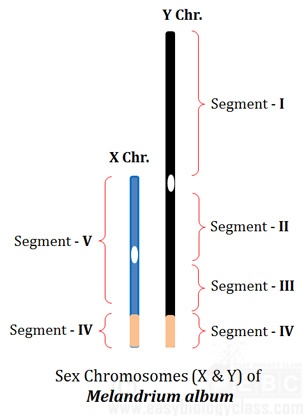Majority of the flowering plants are monoecious with male and female reproductive parts are borne on the same flowers or different flowers of same plant. Only about 6% of Angiosperms are dioecious (male and female flowers on separate plants). The studies of sex determination mechanisms in plants were done only in very few species, such as Coccinia, Asparagus and Melandrium. Melandrium album or Silene latifolia (synonym) is a dioecious model plant in genetics belongs to the Family Caryophyllaceae. The diploid chromosome number of Melandrium album is 24 (n = 12).
This post describes the genetic mechanism of sex determination in Melandrium album or Silene latifolia.
Melandrium album shows sex chromosomal sex determination. They have X and Y sex chromosomal constitution similar to Drosophila and Human. However, the mechanism of sex determination is quite different from the usual XX – XY system. In Melandrium album, the AAXX individuals will be females and AAXY individuals will be males.
| You may also like NOTES in... | ||
|---|---|---|
| BOTANY | BIOCHEMISTRY | MOL. BIOLOGY |
| ZOOLOGY | MICROBIOLOGY | BIOSTATISTICS |
| ECOLOGY | IMMUNOLOGY | BIOTECHNOLOGY |
| GENETICS | EMBRYOLOGY | PHYSIOLOGY |
| EVOLUTION | BIOPHYSICS | BIOINFORMATICS |
The Y chromosome plays a crucial role in the sex determination of Melandrium album. The Y chromosome contains male determining genes and female suppressing genes, both are necessary for the development and maturation of fertile anthers in the male plants. Since the female individuals are homogametic, (produce only one type of gametes – XX constitution) the segregation of X and Y chromosomes occurs only in the male individuals during meiosis.
Usually plants with AAXY chromosomal constitution are males. Sometimes AAXY individuals will be hermaphrodite (bisexual) or androhermaphrodites (forming both bisexual and male flowers on the same individuals). The formation of bisexual individuals in AAXY individuals may be due to the mutation or deletion of the female suppressing genes on the Y chromosome or due to the change in DNA methylation pattern.
Mechanism of sex determination in Melandrium album:
Melandrium album (syn: Silene latifolia) source wikipedia
Sex determination mechanism in Melandrium album was first proposed by Warmke H.E. (1946). As we mentioned previously, the AAXX individuals will be females and AAXY individuals will be males. The plants may be diploids, triploids or tetraploids in their chromosomal constitution. Irrespective of the ploidy of the chromosomes, the presences of a single Y chromosome produce male plants. Thus XY, XXY and XXXY individuals will be males. However XXXXY individuals will be hermaphrodite (bisexual). This shows that one Y chromosome is equal to four X chromosomes. This observation leads to the detailed study of sex chromosomes (X and Y) in Melandrium.
Structure of X and Y sex chromosomes in Melandrium album
In Malandrium album, the Y chromosome is longer than X chromosome. The X and Y chromosomes form a heteromorphic bivalent during the meiotic prophase.
The X and Y chromosome are divided into five segments as in the figure. These segments control the development of sex organs in the plant. As in the picture, the X and Y chromosomes have a common segment (segment – IV) which is used for homologous pairing during meiosis. The remaining Y chromosome has three parts namely segment – I, II and III. Similarly, the remaining X chromosome has one segment called segment V.

.
Y chromosome segments and its functions:
@. Segment – I: Suppress femaleness: it inhibit the development of female structure in the flower
@. Segment – II: Initiate anther development
@. Segment–III: control the later stages of anther development (segment II and III are essential for the formation of functional- fertile anthers
@. Segment-IV: Homologous with region IV on X chromosome, used for pairing with X-chromosome during meiotic prophase
X chromosome segments and its functions:
@. Segment-IV: Homologous with region IV on Y chromosome, used for pairing with Y-chromosome during meiotic prophase
@. Segment-V: X chromosome specific region, it promote femaleness in the absence of segment I on Y chromosome
A plant with AAXY constitution that lacking segment I of Y chromosome due to mutation or deletion, will be bisexual. This is because, in the absence of segment I on the Y chromosome (whose function is to suppress femaleness) the segment V on X chromosome promote the development of female structures. This flower will NOT be a female flower because, segment II and II on Y chromosome is still there in the chromosome which produce the fertile anthers.
| You may also like... | ||
|---|---|---|
| NOTES | QUESTION BANK | COMPETITIVE EXAMS. |
| PPTs | UNIVERSITY EXAMS | DIFFERENCE BETWEEN.. |
| MCQs | PLUS ONE BIOLOGY | NEWS & JOBS |
| MOCK TESTS | PLUS TWO BIOLOGY | PRACTICAL |
In Melandrium album four whorls of floral organs are observed in both male and female floral meristems, as it is the case for any hermaphrodite species. They are sepals, petals, stamens and carpels. At the early stages of flower development, the floral meristem is completely undifferentiated and similar in male and female plants. When the floral development proceeds, there will be considerable difference in the relative proportion of different floral parts in both male and female plants. In male flowers (AAXY), a sterile filament is developed in place of the carpels. Similarly in female flowers (AAXX) the developments of anthers are first initiated but rapidly it degenerate, whereas five carpels are developed in the centre.

